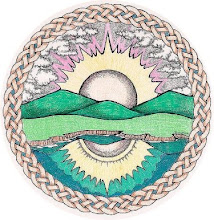"What" would you do?
“How” would you do it?
Brittany’s first prize winning comments about “what” a small “zone of peace” is are worth remembering (see our last posting).
The first part of Brittany’s formula has to do with knowing how to take responsibility for one’s own anger and transform it within oneself into a state of peace. The second part implies that two people, both being similarly responsible in this way, can be together in a shared space – and – maintain a state of peace.
Having spent some time with Brittany when we were conducting our 2006 art and essay contest, I feel assured that her “what” is a deep part of her. So much so that I believe that her “inner knowing” about building zones of peace has led her to seek out the “how.”
(She was, after all, only eleven when last we met. Just beginning to explore the challenges of local and global peace.)
The “how” of building zones of peace moves outward from peace within to a peace that is shared -- with all living beings; people, animals, the elements of nature and the environment.
Brittany’s “what” is a great starting point for the adventure of any small zones of peace building project.
We still, however, have a daunting task ahead of us to –
The first part of Brittany’s formula has to do with knowing how to take responsibility for one’s own anger and transform it within oneself into a state of peace. The second part implies that two people, both being similarly responsible in this way, can be together in a shared space – and – maintain a state of peace.
Having spent some time with Brittany when we were conducting our 2006 art and essay contest, I feel assured that her “what” is a deep part of her. So much so that I believe that her “inner knowing” about building zones of peace has led her to seek out the “how.”
(She was, after all, only eleven when last we met. Just beginning to explore the challenges of local and global peace.)
The “how” of building zones of peace moves outward from peace within to a peace that is shared -- with all living beings; people, animals, the elements of nature and the environment.
Brittany’s “what” is a great starting point for the adventure of any small zones of peace building project.
We still, however, have a daunting task ahead of us to –
- Know the day-to-day “how” of building small zones of peace, and;
- Develop skill in maintaining these small zones of peace, once constructed.
- Sustainable practices for resolving conflict between members; and
- Skill at creating elegant solutions for solving the problems that arise in conflict areas.
We call groups that function in this manner – exceptional communities. The New Horizons’ Small “Zones Of Peace” Project has created an intriguing model for training and empowering exceptional leaders (in our model "followers" are also demonstrating a kind of leadership) and developing exceptional communities.
Our community development model and our personal commitments to functioning, individually and collectively, in this fashion are “how” we build small “zones of peace.”
Think about it -- the "what" (of your vision) and the "how" (of your method) for building zones of peace. At least building small ones by thinking globally, acting locally, minute-by-minute. Nothing necessarily grand. Just "being" the peace you wish there to be.
Imagine!
What more could you do today to build zones of peace everywhere you go?
And how can you achieve this, day-by-day? Today, more than yesterday.
Tomorrow, more than today.
Send me your visions and viewpoints at zonesofpeacenh@aol.com.
Maybe it's even time for us to consider plans for our another art and essay contest.
You might be our next first prize winner!


No comments:
Post a Comment